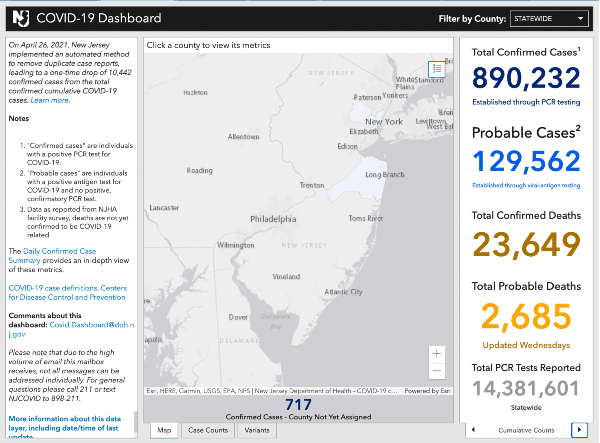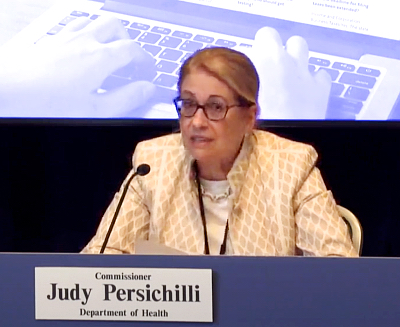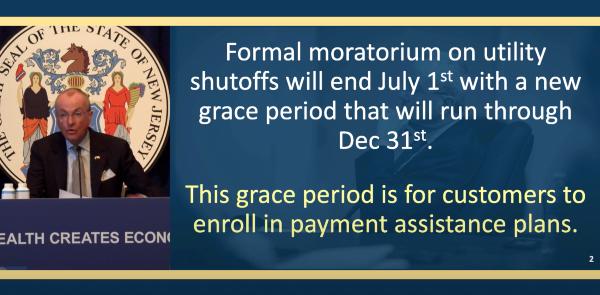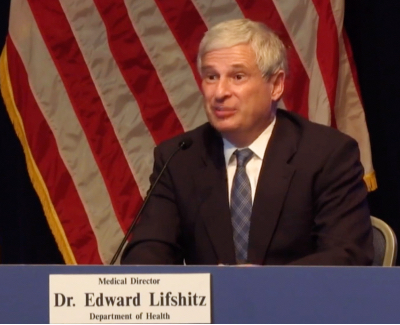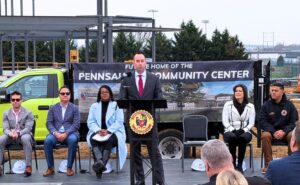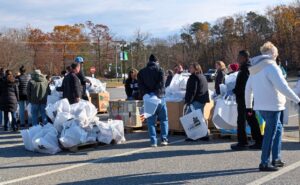Gov. Phil Murphy estimates that ‘hundreds of thousands’ of New Jerseyans will need the remainder of the year to get into repayment plans over pandemic-related arrearages. Plus: when will the pandemic be over?
By Matt Skoufalos | June 14, 2021
Another 138 New Jersey residents have tested positive for novel coronavirus (COVID-19), bringing the statewide total to 890,232 cases confirmed via polymerase chain reaction (PCR) testing, Governor Phil Murphy reported Monday.
New Jersey is also reporting 122 new COVID-probable cases based on antigen tests, bringing the statewide total to 129,562 positive antigen tests.
Antigen tests have a faster turnaround time than PCR tests—sometime within 15 to 30 minutes—but are less reliable at detecting active infection of the virus, and more capable of reporting false positives.
Sadly, five more residents have perished from complications related to the virus, bringing the statewide, confirmed death toll to 23,649 lives lost during the pandemic.
In addition to those lab-confirmed fatalities, the state has acknowledged another 2,685 probable COVID-19-related deaths.
Since March 2020, 978 of every 100,000 New Jersey residents have been hospitalized with COVID-19, and 269 of every 100,000 have died from COVID-19-related complications.
More than 14.381 million polymerase chain reaction (PCR) tests for COVID-19 have been performed statewide, with a 10.124-percent positivity rate per 100,000 residents.
Rate of transmission (Rt) at 0.90, spot positivity lowest in South Jersey
The statewide average of COVID-19 spot positivity testing based on PCR test results stood at 1.01 percent June 10; in South Jersey, it was lowest, at 0.80 percent.
Rt, the variable that describes the seven-day, rolling-average, statewide rate of transmission of new COVID-19 cases, hit 0.90 on June 14.
Any Rt figure less than 1.0 means that each new COVID-19 patient is infecting fewer than one other person, on average, and the spread of the virus is decreasing.
Since its mid-April-2020 COVID-19 spike, the highest reported RT in New Jersey was 1.48, recorded August 1, 2020. Prior to artificially low, adjusted reports of 0.34 in the first week of May, the lowest in the past year was 0.62, recorded June 9, 2020. On May 21, 2021, it reached a new low, of 0.59.
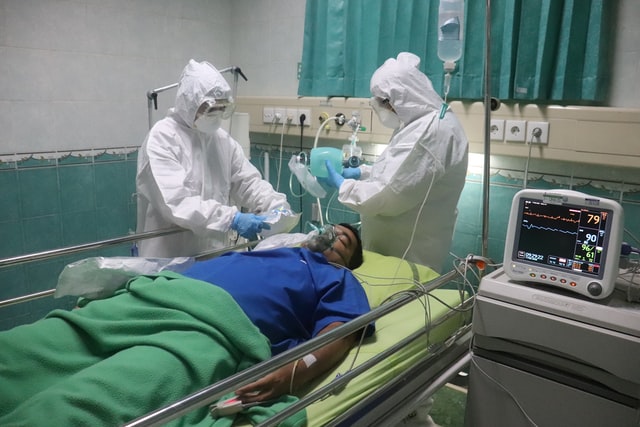
Simulated COVID-19 patient in a hospital bed. Photo by Mufid Majnun on Unsplash
Hospitalizations continue sustained decline
Throughout New Jersey, 361 people currently are hospitalized with a suspected (295) or confirmed (66) case of COVID-19, Murphy said.
Among those hospitalized patients, 86 are in intensive or critical care, and 54 of the ICU and critical-care patients (63 percent) are on ventilators.
In New Jersey’s 71 critical care hospitals, 31 patients were hospitalized with COVID-19 yesterday, while 43 others were discharged.
LTC update
Across the state, long-term care (LTC) centers have reported 1,474 cumulative outbreaks of COVID-19, and 65 are dealing with an active outbreak. LTCs account for 55,005 infected patients and staff in New Jersey, or 6.2 percent of total cases.
That includes 32,777 residents and 22,228 staffers sickened by the virus, as well as 8,058 lab-confirmed resident and staff deaths (34 percent of the statewide confirmed total), with facilities self-reporting 144 staff deaths.
Of 623 veterans residing in three state-run homes, 456 residents have tested positive for COVID-19, and 156 have died from complications related to the virus. Three hundred veterans have recovered from the virus.
The facilities at Menlo Park, Paramus, and Vineland are staffed by 1,335 workers, two of whom are presently COVID-19-positive. The facilities have sustained two staff deaths related to the virus; two staffers are currently COVID-19-positive.
At state-run psychiatric facilities, 367 of 1,122 patients and 1,075 staff members have tested positive for COVID-19. Fourteen patients and eight staffers have died from complications related to the virus.
On Monday, New Jersey Health Commisisoner Judy Persichilli said the New Jersey Department of Health will be issuing guidance for reopening adult medical day programs, which had been closed during the pandemic, for those centers that can attest to their ability to follow NJDOH reopening protocols.
MISC cases and schools
To date, 127 New Jersey children aged 1 to 18 have been diagnosed with pediatric multisystem inflammatory syndrome (MISC). Four of those cases were reported in Camden County, tied with Cumberland and Monmouth Counties for third-least in the state.
All those pediatric patients have tested positive for an active COVID-19 infection or the presence of COVID-19 antibodies, indicating exposure to the virus. No deaths have been associated with this syndrome in New Jersey, although several children have been hospitalized during their treatment for the illness.
Since August 1, 2020, 281 COVID-19 outbreaks encompassing 1,263 individual cases have been traced to schools in all 21 New Jersey counties. In Camden County, 18 outbreaks have been linked to 78 cases, sixth-most in the state.
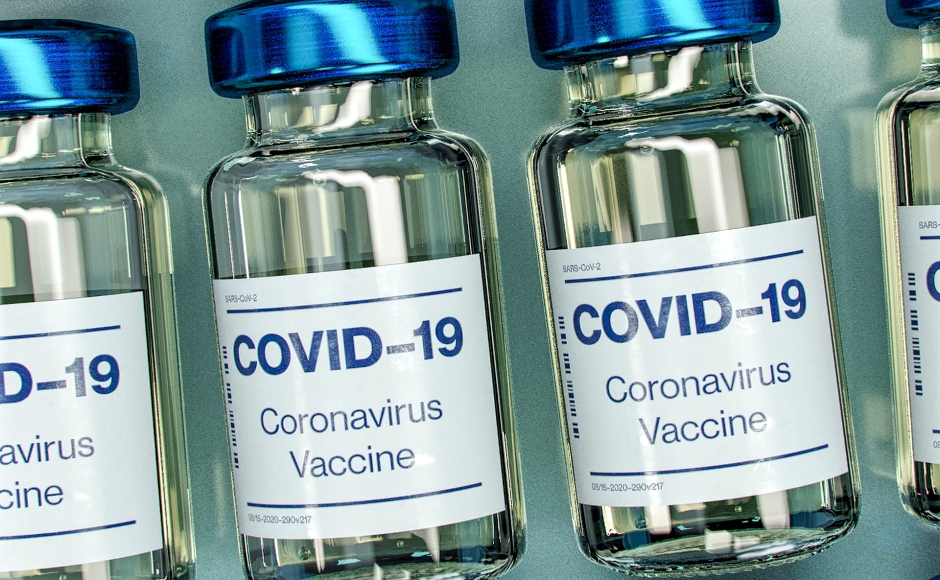
COVID-19 vaccine bottle mock-up. Photo by Daniel Schludi on Unsplash
Vaccination update: NJ surpasses 4M fully vaccinated people, 9M doses administered
Across New Jersey, 9.550 million COVID-19 inoculations have been administered.
Throughout New Jersey, 4.393 million people have been fully vaccinated in-state, having received either a one-shot formulation from Johnson and Johnson or both doses of the two-shot Pfizer or Moderna vaccines.
In Camden County, 502,755 doses have been administered; seventh-most in the state.
An estimated 357,974 New Jersey residents have received a vaccine dose outside of the state, of which 171,143 are estimated to have been fully vaccinated.
The first vaccines in the state were administered December 15, 2020; by February 8—55 days later—New Jersey had immunized its millionth resident. Twenty days thereafter, that count hit 2 million, and 3 million within two more weeks.
On March 29, New Jersey crossed the 4-million-dose threshold, and the state cleared 5 million doses over the weekend of April 10, 2021. Eight days after that, New Jersey hit the 6-million-dose mark. By May 3, 2021, the state had cleared 7 million doses administered, and two weeks later, it had surpassed 8 million doses. As of June 2, 2021, the state had cleared 9 million administered doses and 4 million fully vaccinated New Jerseyans.
According to Persichilli, the percentage of New Jerseyans who have received at least one vaccine dose varies by age, with the oldest residents accounting for the bulk of inoculations:
- 88 percent of those 65 and older have received at least one vaccine dose, and 80 percent of them are fully vaccinated
- 76 percent of those aged 50 to 64 have received at least one dose
- 63 percent of those aged 30 to 49 have received at least one dose
- 53 percent of those aged 18 to 29 have received at least one dose
- 39 percent of those aged 16 to 17 have received at least one dose
- 33 percent of those aged 12 to 15 have received at least one dose
“Fully vaccinated people are much safer to engage in everyday life than unvaccinated people,” Murphy said, encouraging residents to “get vaccinated as soon as possible.”
“This is becoming, increasingly, by the day, a pandemic of unvaccinated individuals,” he said.
On Monday, Persichilli reported that the impact of COVID-19 tumbled among vaccinated adults from December 2020 to April 2021, from infection to hospitalization to death rates.
Older New Jerseyans, who were first in line for their COVID-19 vaccines, reported a 40-percent less incidence of the virus as compared with those aged 18-49 during that time period. Similarly, COVID-19-related emergency room visits (down 59 percent), hospital admission (down 69 percent), and death rates (down 66 percent) all declined among those vaccinated versus those unvaccinated people for the five months in question.
“The greater decline in COVID-19 morbidity and mortality in older adults, the age group with the highest vaccination rates, demonstrates the benefit of increasing population-level vaccination coverage,” Persichilli said.
Variants of concern
Mutated offshoots of COVID-19, or “variants of concern,” continue to circulate throughout New Jersey; the state has traced thousands of such cases to date.
The most common COVID-19 variant in the United States is the B.1.1.7, or “UK” variant, which has been detected in all 21 New Jersey counties.
It accounts for more than 54 percent of the variants identified in the past month, Persichilli said.
It’s associated with a 50-percent increase in COVID-19 transmission over earlier strains of the virus detected in New Jersey, and likely increased severity, based on hospitalization and case fatality rates, Persichilli has said.
Strain B.1.526, which originated in New York state, represents 16 percent of the variants identified in New Jersey in that time, and is a “variant of interest,” Persichilli said.
The P.1 “Brazilian” variant accounts for 3.5 percent of the variants identified in the past month, and B.1.617.2, which originated in India, accounted for 3.1 percent of all specimens sequenced in the past four weeks.
Smaller percentages of the California variants B.1.427 and B.1.429 also were reported in the data, the health commissioner said.
Roughly 2 percent of positive samples are being tested for variants, Dr. Ed Lifshitz, head of the New Jersey communicable disease service, has said.
Breakthrough COVID-19 cases, vaccination impact
In addition to commonly reported data points, New Jersey health officials are tracking COVID-19 outlier statistics, including the number of residents who’ve suffered repeat infections of the virus, and those who constitute “breakthrough” cases; i.e., those who test positive for the virus at least two weeks after having been completely vaccinated.
Between December 15, 2020 and April 23, 2021, the New Jersey Communicable Disease Service identified 1,319 breakthrough cases, or 0.06 percent of the 2.189 million fully vaccinated people in the state.
Of the 1,319 breakthrough cases, 505 had symptoms, 377 did not, and information wasn’t available on 437 others. From the same group, 30 were hospitalized, and seven ultimately perished from causes related to COVID-19, Persichilli said. Hospitalizations and deaths were only seen in those aged 50 and older, and half of those deaths were of those 80 and older.
Lifshitz said those data represent “an undercount of these individuals” because people with mild symptoms, or none at all, are unlikely to be tested for COVID-19. Extrapolated, the information showed that, of 1 million vaccinated people, 602 would test positive for COVID-19, 42 would be hospitalized, and 6 would die from any cause.
NJ ends moratorium on utility shutoffs
Starting July 1, New Jersey utility providers will see the pandemic-ordered moratorium on shutoffs for non-payment lifted.
As per the terms of an executive order Murphy signed today, however, utility customers who are delinquent in their bills will have until December 31 to enroll in payment assistance plans to resolve any unpaid balances with their providers. Seniors and low-income families “will be further protected” by an existing, seasonal moratorium that runs from the depths of winter through the middle of March 2022, Murphy said.
The governor said similar discussions are in effect to address the statewide moratorium on tenant evictions, which is expected to stretch throughout the calendar year as well.
“No one will face disconnection of their gas, electric, or water services before the end of the grace period on December 31, 2021,” the governor said, acknowledging that “hundreds of thousands of New Jerseyans are facing utility arrearages, and need some time to get back on their feet.”
Households in which schoolchildren rely upon Internet providers to participate in online learning will also be safe from disconnection during this period, Murphy said.
“We fully expect every utility provider to work with their customers in good faith,” he said, noting that utility assistance could come from federal American Rescue Plan dollars if needed.
When will the pandemic be over?
In light of improving disease metrics, vaccination and hospitalization rates, and other key data points of the pandemic, the governor was asked today when he anticipates the pandemic will formally be concluded.
Murphy said he’ll measure it by “the level of normalcy in our lives,” including such signifiers as students safely unmasked and back to school in person, and public- and private-sector office workers back in their places of business.
The governor’s estimation is that the prevalence of COVID-19 may become reduced to “something like the flu, so that you’re never completely out of the woods, but back to normal.”
Lifshitz offered a similar opinion.
“This is not going to be like a V-E Day or a V-J Day, where you can declare the war is over,” he said. “I think it’s going to be a continual winding-down. You’ve seen that in the relaxation of restrictions all over the place; the public health emergency has ended. I do think you need continued vigilance to make sure that it doesn’t pop back up.”
The work that remains to be continued is reminding people to get vaccinated, monitoring disease vectors, including variant strains of the virus, and keeping severe case counts low, the doctor said.




